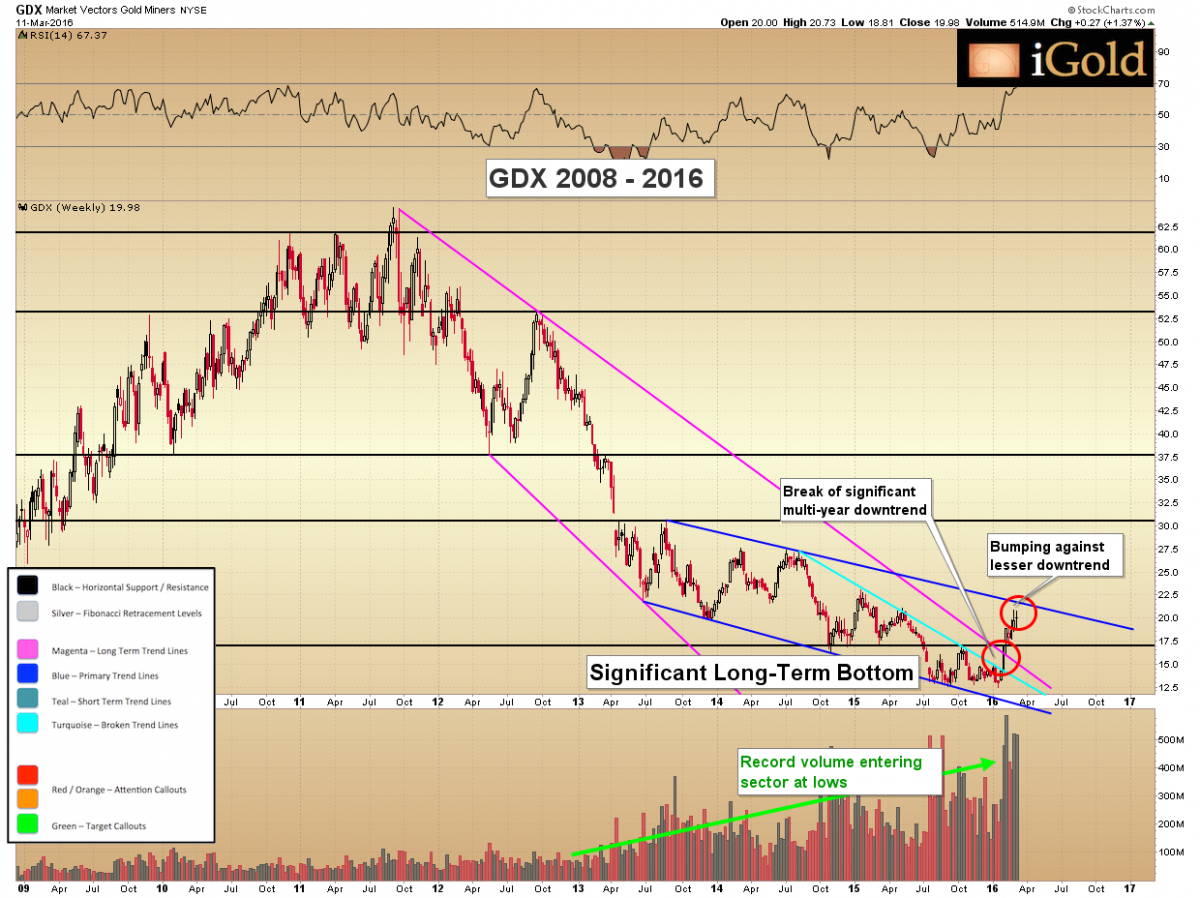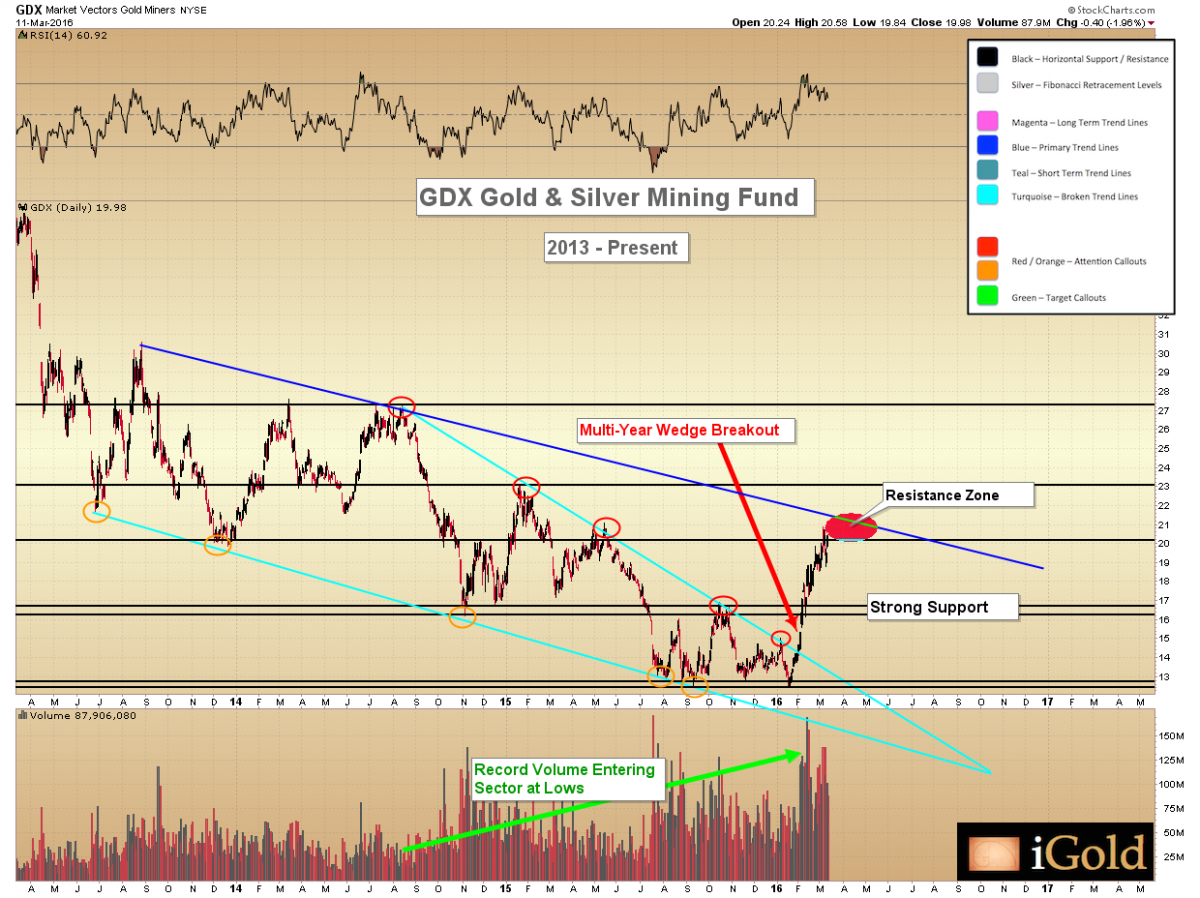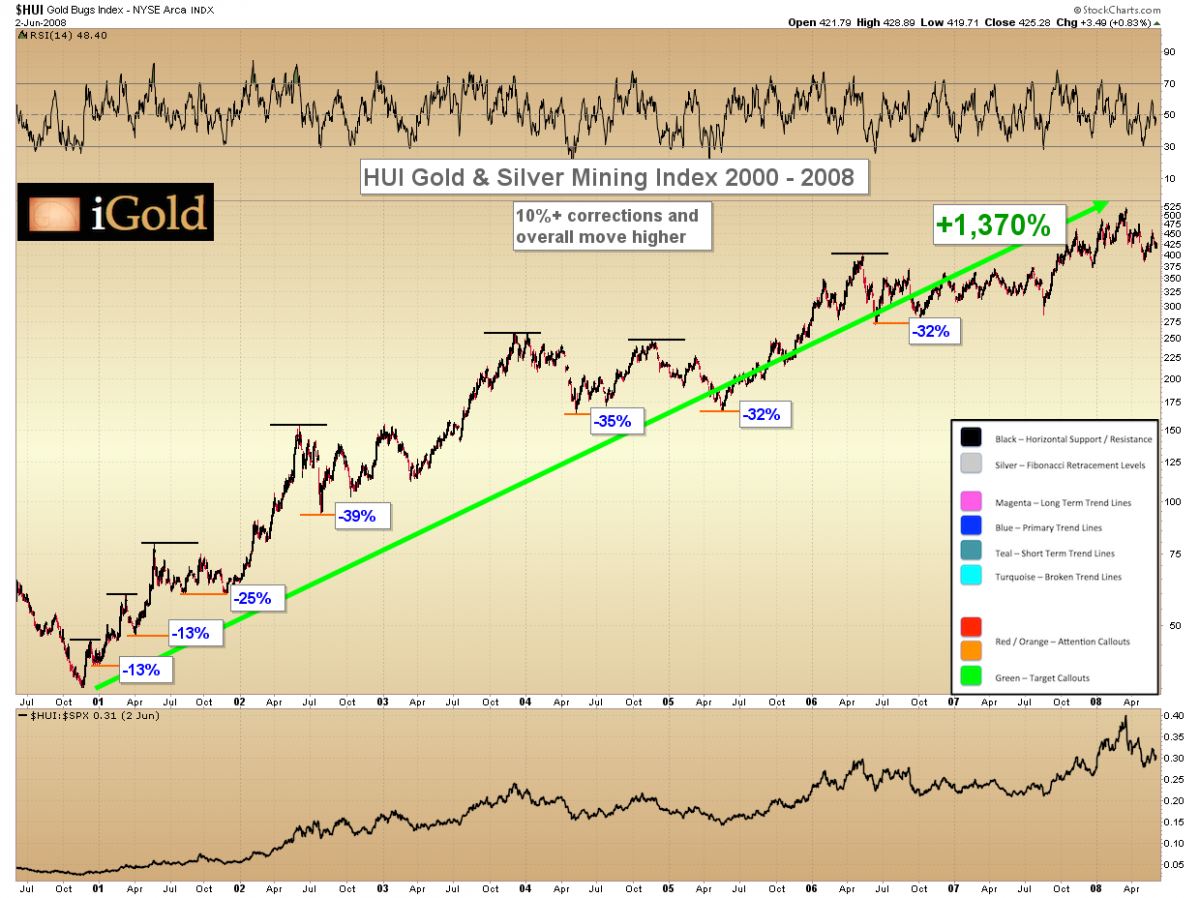The State Of The Gold Mining Industry
 I recently attended the Prospectors and Developers Association of Canada (PDAC) convention in Toronto. The convention was held from March 5-10. It featured approximately 500 companies trying to convince over 20,000 investors to invest in their company stories. The mood was moderately positive, as both the gold and silver sectors, as well as the larger resource sector, look to have finally put in long-term bottoms after the last 5+ years of declines.
I recently attended the Prospectors and Developers Association of Canada (PDAC) convention in Toronto. The convention was held from March 5-10. It featured approximately 500 companies trying to convince over 20,000 investors to invest in their company stories. The mood was moderately positive, as both the gold and silver sectors, as well as the larger resource sector, look to have finally put in long-term bottoms after the last 5+ years of declines.
Sentiment indicators are important to pay attention to as investors. For example, if everyone at the convention was ragingly bullish, it would be an important red flag that the sector had already seen much of its buying, and that, conversely, perhaps an intermediate-term top was forming. After all - if everyone who wants to buy has already bought, then who is left still to buy? Prices would then start moving down even without a fundamental spark, as only sellers remain.
But there was no raging enthusiasm. There was a sense at the convention that, perhaps, the corner has been turned in these markets on a long-term basis, although there was still a healthy amount of fear that, at any moment, another leg down might show itself.
It is said that bull markets must climb "walls of worry," as those who were accustomed to big losses over past years fear that, at each subsequent rise, a new down leg will surely materialize. Overall, I think we are at a healthy psychological balance from which the very beginnings of this new bull market are now in the process of emerging.
Of course, we must keep in perspective the audience we are referring to. The mineral sector, and the gold and silver sub-sectors, are extremely small compared to the rest of the US and world economies. I always keep in the back of my mind that Apple Computer, should it choose to, could buy every single publicly-available gold and silver miner in the world. I sometimes wonder why they do not -- although, clearly, this would be a diversification that most technology investors would not favor.
Still, the point remains that our sector is very small, and so the mood at a targeted mining convention, however bullish or bearish it may be, should not be construed to be representative of the larger investment world as a whole. For example, to get a broader sample size, we might ask the question - how many US or worldwide investors who are automatically invested in 401(k)'s (retirement plans) through their employers are bullish on gold/silver mining equities? I would dare to speculate that the vast majority of individuals who accept the mainstream investment thesis for their retirement plans are not even aware that it is possible to own gold or silver, let alone gold or silver mining equities. Such has been my experience in discussions with diverse sets of individuals over the last several years.
Our sector is generally unknown and unloved from the mainstream perspective, and this is a very healthy backdrop. It means that the vast majority of the potential is ahead of us, not behind us. Most of the smaller companies we are investing in cannot take a tremendous surge of buying interest without revaluing the share price significantly higher - they are just too small in market cap. We are positioning ourselves close to long-term secular bottoms.
When the average person that you meet at the grocery store or the bar is telling you how bullish he or she is on Barrick Gold Corp., for example, then we will have cause for concern that the market is fully saturated. Until then, we must keep the big picture in mind even as we negotiate the smaller moves and take profits at set intervals along the way.
The Recent Bottom In The Gold Mining Sector
Let us look at the sector from a technical standpoint. Shown below is the gold and silver mining sector as expressed by the large-cap GDX fund from 2008 - 2016.
Note that the long-term (magenta colored) multi-year downtrend line has been broken on record high volume. This is, in no uncertain terms, a bottom signal of multi-year significance.
Note that the move higher from the bottom was an impulsive wave, consisting of a 65% gain in a mere four weeks. Such impulsive waves typically signal the start of a multi-year move in the primary direction of the new trend, which in this case, is higher.
Let us zoom into the last few years to view this action closely.
Recent Action In The Gold Mining Sector
Last week's action in the mining sector confirmed that the 20-21 level on the GDX is the first significant resistance zone that the mining sector will have to overcome. Note that resistance does not mean long-term top. Resistance simply means an area in which sellers are first starting to show up after the initial wave higher.
Note that this level corresponds to both the black horizontal resistance line from May of 2015, and to the lesser blue downtrend previously mentioned. It is, thus, a confluence of two resistance levels.
Indeed, after rocketing up 65% in four weeks, this market needs to take a breath. If that trend were to continue, it would represent an annualized gain of 780% - which would be wonderful, but not realistic.
So what may happen now?
Many fear a significant correction, but we do not see such occurring at this early juncture. From the GDX close on Friday at 19.98, our strong support level comes in at the 16-17 range, as shown above. This level represented the former October high that was breached decisively in February.
Using the 16 level as a lower-case scenario, we would be looking at a 20% hypothetical correction if it were to materialize. Of course, it is also possible that the GDX simply consolidates for the next few months below the blue downtrend before breaking higher in the next wave up this summer or fall.
Such a correction or consolidation should give latecomers an excellent opportunity to begin initiating positions.
A Look At Historical Gold/Silver Mining Corrections
Let us turn our focus to the HUI Gold & Silver Mining Index, which is comparable to the GDX, but has data dating back further for our study.
The precious metals bottom that formed in 2000, that then led to an 8-year bull market, warrants some comparisons. Below we look at all the 10+% corrections that occurred during this time period.
Note how the first two corrections off the lows were only 13%. As the move progressed, the corrections became bigger. Also note that, despite these corrections, the overall move higher over this time period was 1,370%.
Further, note that the first two 13% corrections only lasted for 2-3 weeks. To trade in and out of these first corrections would have been very difficult, indeed.
Finally, let us remember that despite all of these corrections, the last precious metals bull market resulted in a 1,370% gain across the large cap miners, and greater percentage gains for select companies. Remembering that both relative to the broad S&P 500 and the prices of gold and silver themselves, the mining equities are valued worse than they were in 2000, the gains to come should be even more significant than the 2000-2008 example.
The corrections will come. However, the trend is now higher, and the opportunities are, therefore, immense for astute investors at present.





















